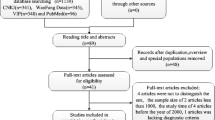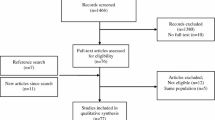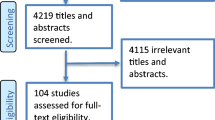Abstract
Gout is a common inflammatory joint disease. Although China is a developing country, it is an ethnically diverse country with regional economic disparities. To date, there are limited studies that investigated the gout prevalence from representative populations in mainland China. Therefore, we performed an updated systematic review and meta-analysis in order to comprehensively review all the relevant published data that reported the prevalence of gout in mainland China from 1998 to 2019. The electronic databases including PubMed and Medline were searched for peer-reviewed articles published in the selected period. Meta-analyses were conducted by using the Comprehensive Meta-Analysis software. After screening and checking for eligibility, we included 67 articles with a total of > 394,768 participants. The pooled estimate of prevalence in the general population was 1.6% (95% CI, 1.2–2.2%). Gout prevalence rates varied from 0.8 to 5% by regions. The lowest and highest prevalence of gout was found in the Northwest (0.8%) and Southwest (5.0%), respectively. The prevalence rate was higher in males than in females (1.9% (95% CI, 1.5–2.4%) vs. 0.5% (95% CI, 0.3–0.8%) (P < 0.001). All funnel plots were symmetrical and no indication of publication bias was observed for all analyses. In conclusion, the prevalence of gout was reported to be on the rise. In addition, the burden of gout is also increasing in China. With the increasing aging populations and obesity rate in mainland China, the evidence from this updated systematic review and meta-analysis will be significant to prompt for optimizing management and treatment of gout at individual and population levels.




Similar content being viewed by others
References
Martillo MA, Nazzal L, Crittenden DB. The crystallization of monosodium urate. Curr Rheumatol Rep. 2014;16(2):400.
Kuo C-F, Grainge MJ, Zhang W, Doherty M. Global epidemiology of gout: prevalence, incidence and risk factors. Nat Rev Rheumatol. 2015;11:649–62.
Multidisciplinary Expert Task Force on Hyperuricemia Related Diseases. Chinese multidisciplinary expert consensus on the diagnosis and treatment of hyperuricemia and related diseases. Chin Med J. 2017;130(20):2473–88.
Kim Y, Oh H-C, Park JW, Kim I-S, Kim J-Y, Kim K-C, et al. Diagnosis and treatment of inflammatory joint disease. Hip Pelvis. 2017;29(4):211–22.
Singh JA. Racial and gender disparities among patients with gout. Curr Rheumatol Rep. 2013;15(2):307.
Roddy E. Revisiting the pathogenesis of podagra: why does gout target the foot? J Foot Ankle Res. 2011;4(1):13.
Perreault S, Nuevo J, Baumgartner S, Morlock R. Any link of gout disease control among hypertensive patients and onset of end-stage renal disease? Results from a population-based study. World J Nephrol. 2017;6(3):132–42.
Zhou H, Ma ZF, Lu Y, Du Y, Shao J, Wang L, et al. Elevated serum uric acid, hyperuricaemia and dietary patterns among adolescents in mainland China. J Pediatr Endocrinol Metab. 2020;33(4):487–93.
Chen Y, Tang Z, Huang Z, Zhou W, Li Z, Li X, et al. The prevalence of gout in mainland China from 2000 to 2016: a systematic review and meta-analysis. J Public Health. 2017;25(5):521–9.
Yan S, Zhao S, Li C, Wang Y, Wang P, Wang Z, et al. A five years follow up study on patients with gout and hyperuricemia. Chin J Endocrinol Metab. 2011;27(7):548–52.
Moher D, Liberati A, Tetzlaff J, Altman DG. Preferred reporting items for systematic reviews and meta-analyses: the PRISMA statement. PLoS Med. 2009;6(7):e1000097.
Du H, Chen S, Wang Y, Xu L. An epidemiological investigation on community hyperuricemia and gout in Huangpu district, Shanghai. Chin J Rheumatol. 1998;2(2):1.
Jiang B, Zhang Y, Xu X, Mei H, Ding F, Wang G, et al. The prevalence of gout and hyperuricemia in Shandong province. China Public Health. 1999:27–8.
Wang Q, Chen R, Du L, Zeng Q. An epidemiological and clinical study of primary gout. Chin J Intern Med. 2001;40(5):313–5.
Shao J, Mo B, Yu R, Li Z, Liu H, Xu Y. Epidemiological study on hyperuricemia and gout in community of Nanjing. Chin J Dis Control Prev. 2003;7(4):305–8.
Shi F, Gu K, Lu W, Weng W, Zhu M, Peng Y, et al. Study on the prevalence of arthritis and relevant factors in Shanghai. Chin J Epidemiol. 2003;24(12):1136–40.
Zhang X, Yu W, Sun Z, Liu D, Zhang C, Zhang L. Investigation of hyperuricemia in Haiyang city, Shandong province. Chinese J Naut Med Hyperbaric Med. 2004;11(2):112–3.
Zeng X. Epidemiological investigation on hyperuricemia and gout among railway workers in Nanning. Hei Long Jiang Med J. 2005;29(11):876–7.
Chou Y, Yan F. Survey and analysis on the health status of 546 retired cadres in Yancheng. J Baotou Med Coll. 2006;22(3):262–4.
Fang W, Huang X, Wang Y, Chen W, Zhu W, Chen J, et al. An epidemiological study of gout in population in Beijing. Basic Clin Med. 2006;26(7):781–5.
Mao Y, Zhou L, Ye H, Huang T, Chen C, Du J, et al. Epidemiological survey on prevalences of hyperuricemia and gout in staff of a petrochemical corporation in Ningbo. Chin J Endocrinol Metab. 2006;22(4):338–41.
Miao Z, Zhao S, Wang Y, Li C, Wang Z, Chen Y, et al. Epidemic characteristics of gout and primary hyperuricemia in Shandong coastal area: a randomized stratified cluster sampling survey. J Clin Rehab Tissue Eng Res. 2007;11(30):6087–91.
Miao Z, Zhao S, Wang Y, Li C, Wang Z, Chen Y, et al. Epidemiological survey of hyperuricemia and gout in coastal areas of Shandong Province. Chin J Endocrinol Metab. 2006;22(5):421–5.
Zhang X, Yu W, Yu L, Zhang L, Yu Y. An epidemiologic study on hyperuricaemia and gout in residents of coastal areas of Haiyang City in Shandong. Chin J Gen Pract. 2006;5(4):216–9.
Han L, Zhang W, He W. Epidemiological survey on gout prevalence among young and middle-aged people in Qingdao area. Chin J Misdiagn. 2007;7(13):3176–7.
Wu W, Guo J, Yang W, Luo H. The prevalence of hyperuricemia and gout among 1482 subjects for health check in Guangzhou. Hainan Med J. 2007a;18(9):110.
Wu W, Liu Y, Luo H, Guo J. The epidemiology of hyperuricemia and gout in youth and middle-aged residents in a community of Guangzhou City. Clin Med China. 2007b;23(z1):31–3.
Yao Z, Jiang S, Liu H, Wan X, Ding Z. Epidemiological study on hyperuricemia and gout in the coastal area of Qingdao city. Chin J Rheumatol. 2007;11(11):672–5.
Pan P. Epidemiological investigation of gout in Shenzhen area. Chin J Misdiagn. 2008;8(31):7807–8.
Wu W, Guo J, Yang W, Zhong Z, Liu Y, Luo H. Epidemliology of hyperuricemia and gout in a community in Gilangzhon. Chinese J Gen Pract. 2008;6(7):728–9.
Ye Z, Gao L, Yang C, Xu J. Analysis on current situation of chronic disease and its influencing factors in insular residents. ChinJ Public Health Mgmt. 2008;24(5):520–1.
Zeng X, Chen B, Zeng F, Hou C, He Q, Huang L, et al. Epidemiological survey of common rheumatic in Guangxi Nanning Zhuang population. J Pract Med. 2008;24(8):1432–4.
Chen X, Yang H, Yang J. Investigation on the prevalence of hyperuricemia and gout in urban residents in Dali, Yunnan province. China Pract Med. 2009;4(10):257–9.
Jia Y, Cui L, Yang W, Shu R, Song H, Han Y, et al. Epidemiological survey on morbidity of hyperuricemia and gout in Tangshan Mining District. Chin J Coal Industry Med. 2009;12(12):1933–5.
Li M, Yu C, Chen Z, Liu Y, Xu J, Li F. Investigation on health status and health service demand of urban and rural residents in Huicheng district, Huizhou city. Contemp Med. 2010;16(31):1–3.
Wang K, Fu Z, Li C, Liu S, Miao Z, Yan S, et al. Survey of hyperuricemia and gout in two villages of Fushan township of Zhaoyuan in Shandong province. Acta Academiae Med Qingdao Universitatis. 2010;46(5):380–3.
Yu J, Yang T, Diao W, Cai X, Li T, Zhong H, et al. Epidemiological study on hyperuricemia and gout in Foshan areas, Guangdong province. Chin J Epidemiol. 2010;31(8):860–2.
Zhu Y, Nie S. Analysis of physical examination results of elderly people in Pingjiang district, Suzhou and thoughts on follow-up management. J Commun Med. 2010;8(1):3–5.
Zou J, Yang J, Zhang Y, Tian L, Dong J. Spectrum of rheumatoid diseases of Qiang in Mianyang before and after Wenchuan earthquake. Med J West China. 2010;22(8):1558–60.
Guli A, Zhang C, Chen H. Correlation between hyperuricemia and risk factors among senior intellectuals in colleges and universities in Lanzhou. Chinese J Gerontol. 2011;31(9):1508–9.
Hu Y, Maimaiti Y, Aisha A. Epidemiological survey of hyperuricemia and gout in Uygur population of Xinjiang. J Chin Pract Diagn Ther. 2011;25(9):876–7,81.
Yuan S, Li X, Ma Y, Yang Y, Ma X, Huang Y, et al. Epidemiological survey of hyperuricemia and gout in Xinjiang adult population. Chin J Endocrinol Metab. 2011;27(7).
Zhang J, Xu Q, Ying X, Xu Y, Lan X, He X, et al. Investigation and analysis of unhealthy behaviors of senior managers in private enterprises in western Zhejiang province. Chin Rural Health Serv Admin. 2011;31(9):959–60.
Zou J, Yang J, Dong J, Zhang Y, Tian L, Gu Y. Epidemiological investigation of hyperuricemia and gout in Beichuan Qiang people. Contemp Med. 2011;17(31):12–4.
Cheng L, Jiang J. Analysis of factors affecting elderly men with gout in community. China Modern Doctor. 2012;50(2):9–10.
Gu Y, Zhong X, Wang F. An epidemiological study on rheumatic immunity diseases of Qiang ethnic group in Beichuan after Wenchuan earthquake. Chin J Ethnomed Ethnopharm. 2012;21(8):28,30.
Jiang X. Epidemiological investigation and analysis of chronic diseases in Hengxi town, Ningbo city in 2011. Modern Pract Med. 2012;24(10):1153–5.
Li X, Lin C, Liu Y, Wang L, Yu W. Investigation of hyperuricemia in 1573 army cadres. ChinJ Health Care Med. 2012;14(6):445–8.
Song Y, Zhu K, Yu H, Zhuang X. Significance of establishing chronic disease spectrum of residents in Haizhu District, Guangzhou. J Public Health Prev Med. 2012;23(4):39–41.
Wu L, Song X, Ku B, Shi Y, Huang C, Huang J, et al. Epidemiological study on hyperuricemia and gout in Uygur population in Turpan area of Xinjiang. J Peking Univ (Health Sci). 2012;44(2):250–3.
Huang J, Zhou B, Chen S, Dong J. A cross-sectional study on gout and hyperuricemia in community population. Zhejiang J Prev Med. 2013;25(7):8–10.
Chen R, Bai Y, Su H, Cheng N, Li H, Ding J, et al. Analysis of influencing factors of gout in occupational crowd of Jinchang city. Chin J Prev Control Chronic Dis. 2014;22(6):659–62.
Cui S, Wang X, Tian Z, Wei H, Tian X, Yi Y. Epidemiological study on hyperuricemia and gout in community of Yu County in Hebei province. Chin J Hemorheol. 2014a;4:501–3,15.
Cui S, Wei H, Tian Z, Wang X, Zhao Y, Yi Y. Investigation on the prevalence of hyperuricemia and gout in Yuxian workers in Zhangjiakou area. Clin Focus. 2014b;9.
Song W, Liu J, Chen Z, Huo Y, Lin H, Zhang Y. Hyperuricemia and gout: a prevalence survey among over-40-year-old community residents in Nanchang district. Chin General Pract. 2014;17(2):181–4.
Yang F, La Z, Liu L, Lin B, Yu L, Qu N. Discussion on gout prevalence rate and its influencing factors in Lhasa residents in 2012. Yiayao Qianyan [J]. 2014;(10):26–7.
Zhang P, Zhang L, Wang C, Wei S, Qiao X. A survey of hyperuricemia and gout in people over 30 years old in Xingtai mountains. Pract Prev Med. 2014;21(8):1010–2.
Zhou H, Wang S, Yi X, Yin H, Yang Y, Ji Y, et al. Investigation on nutrition and health status of elderly population in Lishui district, Nanjing city. Chongqing Med [J]. 2014;43(25):3333–5.
Bate B, Da J, Xia B, Chen P, Ou Y, Luo F, et al. Epidemiological investigation of hyperuricemia and gout in Bozhou, Xinjiang. World Latest Med Information. 2015;15(41):99–100.
Gong X, Wang Z, Chen M, Liu Y, Tong Y, Zhou P, et al. Investigation on the health status and demand of the empty nester in Hubei province. Med Soc. 2015;9:10–2.
Hong X, He N, Li H, Zeng Q. Research on prevalence of dyslipidemia and risk factors among 3 911 physical examination cases. Food Nutr China [J]. 2015;21(11):78–81.
Yang L, Song J, Lv L, Lv X, Tang SAM, et al. Epidemiological survey on hyperuricemia and gout among urban population of Lhasa. Med J West China. 2015a;27(10):1476–8.
Yang Y, Li L, Huang X, Yang B. Investigation on chronic diseases of cadres over 60 years old in Chengdu. Chin J Gerontol. 2015b;8(15):4341–3.
Zhou K, Xia M. Epidemiological investigation of hyperuricemia and gout in residents of Luchao port. Int J Lab Med. 2015;36(5):707–9.
Fang L, Chen Q, Wen Y, Gu J. Epidemiologic study of hyperuricemia and gout in Meizhou Area. Clin Res Papers. 2016;47(3):183–6.
Ge Y, Li T, Tao L, Pan X, Li J, Liang Y, et al. Study on the prevalence, characteristics, and clinical nursing of gout and hypertension in the Zhuang people of China. China Med Pharm. 2016;6(3):9–12.
Liu X, Wang X, Guan L, Jin H, He H, Zhang X. Prevalence and associated risk factors of hyperuricemia and gout in Han, Uygur, Kazak, Xibe of Xinjiang Ili Kazak Autonomous Prefecture. Chin J General Pract. 2016;14(7):1186–8,92.
Tan L, Zhu J, Yan M, Lin Y. Epidemiological investigation of gout and hyperuricemia in Huiyang district, Huizhou city from 2008 to 2014. Mod Diagn Treat. 2016;27(10):1919–20.
Wang S, Feng L, Song M, Su Z, Han H, Xu H, et al. Epidemiological survey of hyperuricemia and gout in newly recruited young male soldiers in Hohhot City. Med J Chinese People's Armed Police Forces [J]. 2016;27(1):5–7,11.
Zhao F. Epidemiological investigation and analysis of gout in Xiping county. For All Health. 2016;10(10):25.
Chen X, Li N, Chen Y, Mo H, Li L, Mo X. Epidemiological studies of infected factors on gout and high uric acid hematic disease in Qinzhou district. Lab Med Clinic. 2017;14(23):3470–2.
Wang T, Cai M. Investigation and analysis of disease spectrum of officers and soldiers stationed on the Qinghai-Tibet line. Med J National Defending Forces Southwest China [J]. 2017;27(4):425–6.
Zhou Y, Wang K, Sun M, Liu C. Correlation analysis between career,income and educational level and gout morbidity. J Gansu Sci [J]. 2017;29(6):57–60.
Dong P, Liu X, Du F, Chen J, Feng Y. Survey on health status and lifestyle of 3 types of occupational population in Zhushan county. Med Diet Health. 2018;12(12):131–2.
Jin S, Zhang X, Zheng H, Li F, Yao X. Epidemiological survey of hyperuricemia and gout in Bulang ethnic population in the area of Bulang mountains in Yunnan Province. J Pract Med. 2018;34(22):3796–800.
Xie L, Zhao W, Zhong Y, Wang D, Zhang X. Investigation on the prevalence of hyperuricemia among young students. Natl Med J China. 2018;98(13):987–91.
Wei R, Zhang Y, Zhang F, Peng S, Wang C, Xu G, et al. Prevalence and associated factors of hyperuricemia and gout in elderly people in Xujiahui Subdistrict,Shanghai. Chin General Pract. 2019;22(16):1954–9,72.
Liu R, Han C, Wu D, Xia X, Gu J, Guan H, et al. Prevalence of Hyperuricemia and gout in mainland China from 2000 to 2014: a systematic review and meta-analysis. Biomed Res Int. 2015;2015:762820.
Smith E, Hoy D, Cross M, Merriman TR, Vos T, Buchbinder R, et al. The global burden of gout: estimates from the Global Burden of Disease 2010 study. Ann Rheum Dis. 2014;73(8):1470–6.
McDougall C, Hurd K, Barnabe C. Systematic review of rheumatic disease epidemiology in the indigenous populations of Canada, the United States, Australia, and New Zealand. Semin Arthritis Rheum. 2017;46(5):675–86.
Trifiro G, Morabito P, Cavagna L, Ferrajolo C, Pecchioli S, Simonetti M, et al. Epidemiology of gout and hyperuricaemia in Italy during the years 2005–2009: a nationwide population-based study. Ann Rheum Dis. 2013;72(5):694–700.
Bardin T, Bouee S, Clerson P, Chales G, Flipo RM, Liote F, et al. Prevalence of gout in the adult population of France. Arthritis Care Res (Hoboken). 2016;68(2):261–6.
Hakoda M. Recent trends in hyperuricemia and gout in Japan. Jpn Med Assoc J. 2012;55(4):319–23.
Kim JW, Kwak SG, Lee H, Kim SK, Choe JY, Park SH. Prevalence and incidence of gout in Korea: data from the national health claims database 2007-2015. Rheumatol Int. 2017;37(9):1499–506.
Paul BJ, James R. Gout: an Asia-Pacific update. Int J Rheum Dis. 2017;20(4):407–16.
Tu FY, Lin GT, Lee SS, Tung YC, Tu HP, Chiang HC. Prevalence of gout with comorbidity aggregations in southern Taiwan. Joint Bone Spine. 2015;82(1):45–51.
Kuo CF, Grainge MJ, See LC, Yu KH, Luo SF, Valdes AM, et al. Familial aggregation of gout and relative genetic and environmental contributions: a nationwide population study in Taiwan. Ann Rheum Dis. 2015;74(2):369–74.
Zhang X, Meng Q, Feng J, Liao H, Shi R, Shi D, et al. The prevalence of hyperuricemia and its correlates in Ganzi Tibetan Autonomous Prefecture, Sichuan Province, China. Lipids Health Dis. 2018;17(1):235.
Jefferson JA, Escudero E, Hurtado ME, Kelly JP, Swenson ER, Wener MH, et al. Hyperuricemia, hypertension, and proteinuria associated with high-altitude polycythemia. Am J Kidney Dis. 2002;39(6):1135–42.
Wong R, Ofstedal MB, Yount K, Agree EM. Unhealthy lifestyles among older adults: exploring transitions in Mexico and the US. Eur J Ageing. 2008;5(4):311–26.
Vari R, Scazzocchio B, D'Amore A, Giovannini C, Gessani S, Masella R. Gender-related differences in lifestyle may affect health status. Ann Ist Super Sanita. 2016;52(2):158–66.
Funding
The authors would like to thank Xi’an Jiaotong-Liverpool University for providing support and funding for this hyperuricemia project (SURF code no. 76). The funder had no role in the design of this study and will not have any role during its execution, analyses, interpretation of the data, or decision to submit results. Jiayun Huang would like to thank her parents for providing continuous support in her studies.
Author information
Authors and Affiliations
Contributions
Conceptualization, Z.F.M.; methodology, Z.F.M. and J.H.; formal analysis, Z.F.M., J.H., Y.T., and Y.Y.L.; writing—original draft preparation, Z.F.M. and J.H.; writing—review and editing, Z.F.M., J.H., Y.T., and Y.Y.L.; funding acquisition, Z.F.M.
Corresponding authors
Ethics declarations
Conflict of Interest
The authors declare that they have no conflict of interest.
Ethical Approval
This article does not contain any studies with human participants performed by any of the authors.
Statement of Informed Consent
Informed consent was obtained from all individual participants in the studies included.
Additional information
Publisher’s Note
Springer Nature remains neutral with regard to jurisdictional claims in published maps and institutional affiliations.
This article is part of the Topical Collection on Medicine
Rights and permissions
About this article
Cite this article
Huang, J., Ma, Z.F., Tian, Y. et al. Epidemiology and Prevalence of Gout in Mainland China: an Updated Systematic Review and Meta-Analysis. SN Compr. Clin. Med. 2, 1593–1606 (2020). https://doi.org/10.1007/s42399-020-00416-8
Accepted:
Published:
Issue Date:
DOI: https://doi.org/10.1007/s42399-020-00416-8




